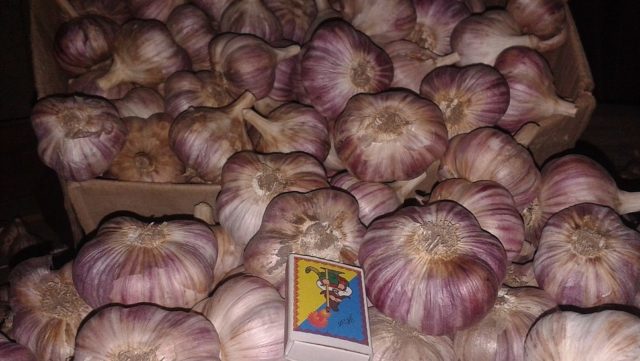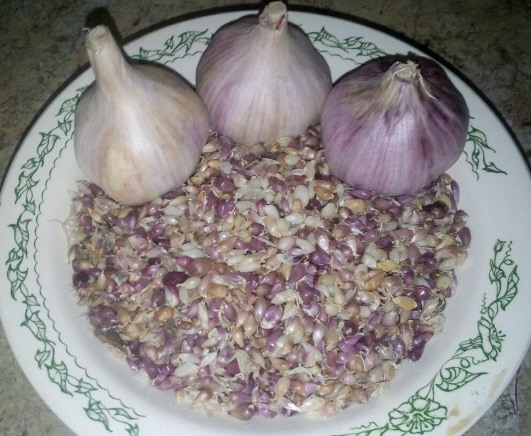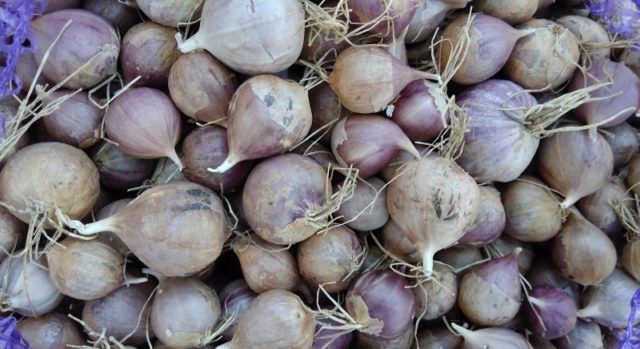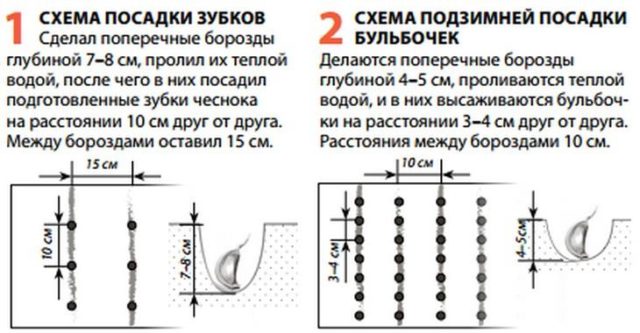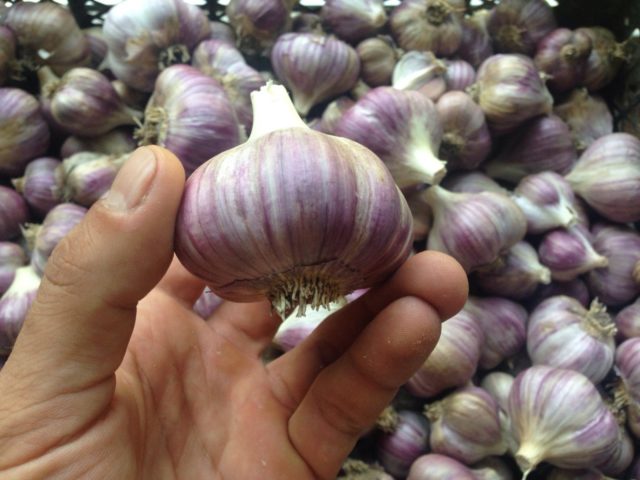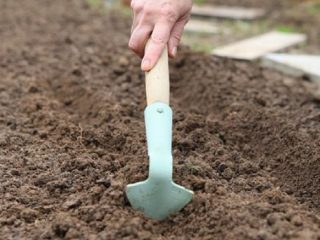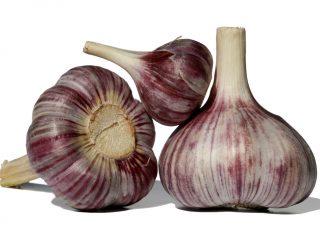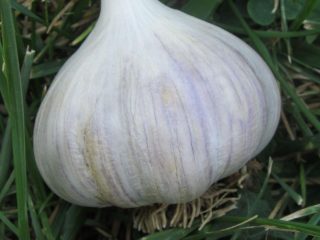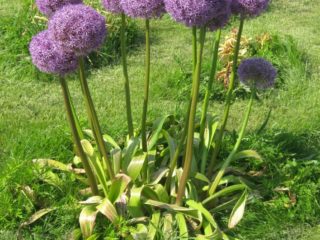Content
Garlic Lyubasha is an unpretentious winter variety with large heads. It is propagated by cloves, bulbs and one-toothed teeth. The high-yielding variety is drought-resistant, little affected by fungal diseases inherent in the species.
Breeding history of the variety
Winter garlic Lyubasha was bred by the Ukrainian gardener and vegetable grower from the Zaporozhye region I.I. Zakharenko, it was tested in 2005-2007. It spread in Russia due to its high yield and unpretentiousness to weather conditions. The new variety has absorbed the best properties of the winter subspecies.
Description of the variety of garlic Lyubasha
The Lyubasha variety surprises with its large-fruited due to its powerful root system. Each specimen has at least 150 roots, which exceeds the performance of other known varieties. The green aboveground part of the plant rises to 1-1.2 m.Under good agrotechnical conditions, it reaches 1.5 m.The width of dense standing leaves with a light waxy bloom is 2-3 cm, the length is 45-50 cm.
Specimens growing from the cloves throw out arrows in the south at the end of May, in the middle lane - in June. The arrows are high, up to 1-1.1 m. The inflorescence creates from 40-60 to 120 air bulbs, with an average weight of each 15 g. There are large bulbs - 20-30 g. Sometimes, when they are sown, arrows are also formed. The germination rate of air bulbs with a diameter of 4-7 mm is 60-70%.
The rounded-flat heads of winter garlic of the Lyubasha variety are striking in size: on average, the diameter reaches 5.5-6.5 cm, weight - 65-80 g. There are 2 times larger, with a weight of 100 to 150 g. The head of the variety weighs 375 d. Bulbs are densely covered with white-pink husks, usually pale in color. The color depends on the minerals, which areas are rich: there are Lyubasha garlic heads with intense pink-purple strokes. Well-developed bulbs are divided into 6-7 large cloves. Ideally, there should be at least 4 slices. A smaller number indicates the degeneration of a given batch of garlic.
The average weight of the slices of the Lyubasha variety is 6-17 g. Dense, crispy flesh of white-cream shade. The taste is spicy, piquant, the aroma is expected, rich in specific essential oils, which are contained in 100 g to 0.4%. A high rate of ascorbic acid - 34 mg, 43% dry matter, 0.3% allicin, 17.0 μg selenium. The bulbs of Lyubasha's high-yield garlic are stable and can be stored without losing their taste for 10 months. Fresh slices are used as a seasoning for hot dishes, for pickles and canned food.
Characteristics of the garlic variety Lyubasha
A variety with excellent qualities is grown on private plots and on plantations on an industrial scale.
The yield of winter garlic Lyubasha
A mid-season variety ripens 3 months after spring shoots. The bulbs are dug up in different regions from the end of June or July. From 1 sq. m receive 1.5-3 kg. On the fields of agricultural enterprises with regular watering and top dressing, Lyubasha's garlic shows yields from 1 hectare to 35 centners. The fee depends on:
- from the nutritional value of the soil;
- its humidification during a drought;
- fertilization.
Due to its developed root system, garlic adapts well to different types of soil, as well as to climatic conditions. Shows excellent productivity in dry years.On a well-mulched area, it safely tolerates frosty winters even without a snow cover. An important role is played by the genetic properties of the Lyubasha variety to resist diseases. The timely removal of arrows is displayed on the yield and weight of the heads. They are torn off when they reach a length of 10 cm.
Disease and pest resistance
Folk selection garlic resistant to fusarium. Pests also rarely attack the plant. If another variety is ill nearby, preventive procedures are carried out.
Advantages and disadvantages of the variety
According to reviews, the Lyubasha garlic variety has many advantages:
- high productivity;
- early maturation;
- frost resistance;
- drought resistance;
- adaptability to soils;
- low susceptibility to disease.
Gardeners do not find any drawbacks in the Lyubasha variety.
How to plant Lyubasha's garlic
The quality of the formed heads or the initial successful stage of its reproduction also depends on the fulfillment of the planting rules.
Landing dates
When planting winter varieties of garlic, it is important to at least roughly navigate the long-term weather forecast when frosts come. The cloves must acclimatize in the soil before the onset of cold weather, it takes up to 16-20 days. This is the best time for planting winter garlic. If the slices are planted long before frost, they germinate, give aboveground seedlings, which will certainly suffer in winter. Planting too late also threatens that the teeth will not take root and may die. In the southern regions, winter varieties are planted in October-November, in the middle lane - from late September to October 10. Soil temperature should be between 10-15 ° C.
Garden bed preparation
On the personal plot for Lyubasha's garlic, they allocate a spacious place, lit by the sun, far from the shade of trees. A lowland or small lonely hill is also not suitable. In the first case, water accumulates in such an area after the melting of snow and rains, which will lead to the death of plantings. On the hill, the snow is blown away by the wind, which further lowers the temperature, and the ground freezes deeper.
2-3 weeks before planting winter garlic, Lyubasha is plowed to a depth of 30 cm, fertilized with mineral agents based on potassium and phosphorus or compost, ripe humus, but not fresh manure.
Planting garlic
During the days that remain until the cloves or bulbs are planted, the grooves are watered 2-3 times. Watering helps to compact the soil. If garlic is planted in too loose soil, the cloves go down, it is difficult for them to germinate. The day before planting, the cloves and air bulbs are soaked for half an hour in a pink solution of potassium permanganate for disinfection. The remaining time they are dried.
Planting scheme for winter garlic:
- grooves deepen to 7-8 cm;
- the interval between the rows of the large-fruited variety Lyubasha is 40 cm;
- the distance between the holes is 10 cm.
Wood ash is poured into the grooves. After deepening the cloves, they are sprinkled with soil and mulched with sawdust, peat, hay.
A decrease in quantity is a signal of the degeneration of this batch of garlic. Also, do not plant sprouting slices.
Growing garlic Lyubasha
With the onset of frost, the site is covered with leaves or spruce branches. After the snow melts, the mulch is removed. The soil is regularly loosened and weeded weeds, on which pests and pathogens can breed. If there are hot days without precipitation, garlic is watered 2-3 times a week. Watering is stopped 14-16 days before the collection of heads. Shooting begins at the end of May. A few inflorescences are left for reproduction, others are pinched off.
In the spring, the culture is fertilized with 20 g of urea per bucket of water. Chicken manure and minerals are also used. When the leaves turn yellow, the plants are supported with ammonia, hydrogen peroxide, and yeast.
Harvesting and storage
Garlic is harvested in the 1st or 2nd decade of July. The heads are gently poured in, left for 1-2 hours to dry and cleaned of soil. Under a canopy, the bulbs are dried for 1-2 weeks, then the stems are cut and laid out in storage boxes in the basement.
Garlic propagation methods
The Lyubasha variety is propagated by:
- teeth, into which the head is divided;
- one-toothed bulbs that have grown from air bulbs;
- air bulbs from ripe inflorescences.
Any planting material of winter garlic is planted only in autumn. The only difference is in the depth of planting lobules and bulbs. The latter are sown to a depth of 5 cm. Before planting, all seeds are disinfected.
Constant, from year to year, reproduction of garlic by cloves from large heads leads to the degeneration of the species. Therefore, those gardeners who are serious about working on the ground must leave a few arrows with seeds for further reproduction.
Diseases and pests, methods of control and prevention
As noted in the reviews, Lyubasha's garlic is not affected by fusarium, but it can become infected with other fungal diseases during the growing season. For prophylaxis, the grown rows are sprayed with a microbiological agent "Fitosporin" or other fungicides. Plants infected with viruses are removed.
Pests are scared away with ammonia during foliar feeding, insecticides are used. The best prevention against nematodes and ticks is pre-sowing soaking of the slices.
Conclusion
Lyubasha's garlic is now the most productive winter variety. Planted on time, mulched for the winter, watered in summer and protected by preventive measures from pests and diseases, garlic in July will delight you with a rich collection of large heads.
